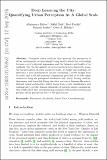Deep Learning the City: Quantifying Urban Perception at a Global Scale
Author(s)
Dubey, Abhimanyu; Naik, Nikhil; Parikh, Devi; Raskar, Ramesh; Hidalgo, César A.
DownloadSubmitted version (8.372Mb)
Open Access Policy
Open Access Policy
Creative Commons Attribution-Noncommercial-Share Alike
Terms of use
Metadata
Show full item recordAbstract
© Springer International Publishing AG 2016. Computer vision methods that quantify the perception of urban environment are increasingly being used to study the relationship between a city’s physical appearance and the behavior and health of its residents. Yet, the throughput of current methods is too limited to quantify the perception of cities across the world. To tackle this challenge, we introduce a new crowdsourced dataset containing 110,988 images from 56 cities, and 1,170,000 pairwise comparisons provided by 81,630 online volunteers along six perceptual attributes: safe, lively, boring, wealthy, depressing, and beautiful. Using this data, we train a Siamese-like convolutional neural architecture, which learns from a joint classification and ranking loss, to predict human judgments of pairwise image comparisons. Our results show that crowdsourcing combined with neural networks can produce urban perception data at the global scale.
Date issued
2016Department
Massachusetts Institute of Technology. Media LaboratoryPublisher
Springer International Publishing
Citation
Dubey, Abhimanyu, Naik, Nikhil, Parikh, Devi, Raskar, Ramesh and Hidalgo, César A. 2016. "Deep Learning the City: Quantifying Urban Perception at a Global Scale."
Version: Original manuscript
ISSN
0302-9743
1611-3349